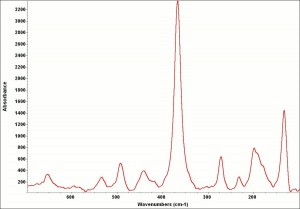Difference between revisions of "Copper arsenite"
Jump to navigation
Jump to search
| (3 intermediate revisions by 2 users not shown) | |||
| Line 2: | Line 2: | ||
A light yellowish-green toxic powder known as the pigment [[Scheele's green]]. Copper arsenite was discovered in Sweden 1775 by C.W. Scheele, a German chemist, but he did not publish the recipe until 1778. Scheele's green was never widely used as a paint pigment because it was toxic and discolored in the presence of acid or sulfur fumes. Currently, it is used as a rodenticide, [[insecticide]], [[fungicide]], and wood preservative. | A light yellowish-green toxic powder known as the pigment [[Scheele's green]]. Copper arsenite was discovered in Sweden 1775 by C.W. Scheele, a German chemist, but he did not publish the recipe until 1778. Scheele's green was never widely used as a paint pigment because it was toxic and discolored in the presence of acid or sulfur fumes. Currently, it is used as a rodenticide, [[insecticide]], [[fungicide]], and wood preservative. | ||
| − | + | [[[SliderGallery rightalign|ScheelesUCL.jpg~Raman (UCL)]]] | |
== Synonyms and Related Terms == | == Synonyms and Related Terms == | ||
Scheele's green; cupric arsenite; Pigment Green 22; CI 77412; mineral green; ash green; cupric acid orthoarsenite; copper orthoarsenite | Scheele's green; cupric arsenite; Pigment Green 22; CI 77412; mineral green; ash green; cupric acid orthoarsenite; copper orthoarsenite | ||
| − | + | == Risks == | |
| − | == | + | * Extremely toxic by ingestion, inhalation and skin absorption. |
| + | * Human carcinogen. | ||
| + | * May produce toxic arsenic fumes when decomposed by fungi. | ||
| + | * NIH: [https://pubchem.ncbi.nlm.nih.gov/compound/Cupric-arsenite Safety sheet] | ||
| + | |||
| + | ==Physical and Chemical Properties== | ||
Soluble in mineral acids, ethanol, ammonium hydroxide. Insoluble in water. Decomposes in alkalis. Darkens in the presence of sulfur or lead compounds. | Soluble in mineral acids, ethanol, ammonium hydroxide. Insoluble in water. Decomposes in alkalis. Darkens in the presence of sulfur or lead compounds. | ||
| Line 16: | Line 21: | ||
|- | |- | ||
! scope="row"| Composition | ! scope="row"| Composition | ||
| − | | | + | | CuHAsO<sub>3</sub> |
|- | |- | ||
! scope="row"| CAS | ! scope="row"| CAS | ||
| Line 28: | Line 33: | ||
|} | |} | ||
| − | == | + | ==Resources and Citations== |
| − | |||
| − | |||
| − | |||
| − | |||
| − | |||
| − | |||
| − | |||
| − | |||
| − | * | + | * D.A.Scott, Copper and Bronze in Art: Corrosion, Colorants, Conservation, Getty Publications, Los Angeles, 2002. |
* Thomas B. Brill, ''Light Its Interaction with Art and Antiquities'', Plenum Press, New York City, 1980 | * Thomas B. Brill, ''Light Its Interaction with Art and Antiquities'', Plenum Press, New York City, 1980 | ||
Latest revision as of 09:26, 8 December 2022
Description
A light yellowish-green toxic powder known as the pigment Scheele's green. Copper arsenite was discovered in Sweden 1775 by C.W. Scheele, a German chemist, but he did not publish the recipe until 1778. Scheele's green was never widely used as a paint pigment because it was toxic and discolored in the presence of acid or sulfur fumes. Currently, it is used as a rodenticide, Insecticide, Fungicide, and wood preservative.
Synonyms and Related Terms
Scheele's green; cupric arsenite; Pigment Green 22; CI 77412; mineral green; ash green; cupric acid orthoarsenite; copper orthoarsenite
Risks
- Extremely toxic by ingestion, inhalation and skin absorption.
- Human carcinogen.
- May produce toxic arsenic fumes when decomposed by fungi.
- NIH: Safety sheet
Physical and Chemical Properties
Soluble in mineral acids, ethanol, ammonium hydroxide. Insoluble in water. Decomposes in alkalis. Darkens in the presence of sulfur or lead compounds.
| Composition | CuHAsO3 |
|---|---|
| CAS | 10290-12-7 |
| Molecular Weight | mol. wt. = 187.5 |
| Refractive Index | 1.55 - 1.75 |
Resources and Citations
- D.A.Scott, Copper and Bronze in Art: Corrosion, Colorants, Conservation, Getty Publications, Los Angeles, 2002.
- Thomas B. Brill, Light Its Interaction with Art and Antiquities, Plenum Press, New York City, 1980
- The Dictionary of Art, Grove's Dictionaries Inc., New York, 1996 Comment: "Pigments"
- Richard S. Lewis, Hawley's Condensed Chemical Dictionary, Van Nostrand Reinhold, New York, 10th ed., 1993
- Random House, Webster's Encyclopedic Unabridged Dictionary of the English Language, Grammercy Book, New York, 1997
